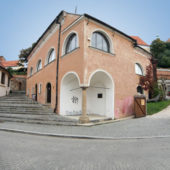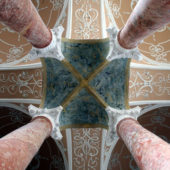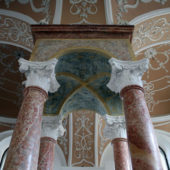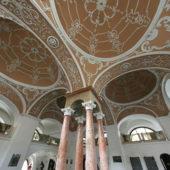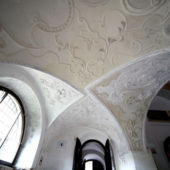Unique design with four central columns.
Built in 1550, the Alteshule-Horni synagogue in Mikulov is one of the few remnants of what was once a leading Jewish community in central Europe. History records Jews in Mikulov (for a long time known in German as Nikolsburg) as early as the 14th century. The population grew significantly in the mid 15th century after pogroms in Poland forced many Jews to flee to this village located in Moravia southeast of Brno in the modern day Czech Republic.
These Jews brought with them their Hasidic traditions which would influence the entire town for the next four centuries. In Mikulov, the Jews found somewhat of a safe sanctuary under the protection of a local prince. In fact, the town developed somewhat of a reputation for tolerance of both Jews and Protestant Christians. In any case, as the Jewish population grew and prospered in everything from wine making and crafts to commerce and medicine, a scholastic tradition also developed centered around a well-respected yeshiva that saw some of the region’s most famous rabbinic scholars including Rabbi Yehudah Loew ben Bezalel (1553-1573). The town became the Chief Rabbinate of Moravia for three centuries.
By the time the Jewish population of Mikulov peaked in early 19th Century, more than 40 percent of the people were Jewish and 12 synagogues had been built to meet their needs. The Alteshule is the earliest one. The synagogue, however, burned in 1719 and was redesigned and rebuilt in Baroque style under the direction of architect J. Ch. Oedtl. The interior features an expansive central hall with four cupolas. The center of the space is dominated by four marble pillars supporting the ceiling, each pillar topped with a Corinthian-style cap. The original synagogue plan was changed in 1890 and the pulpit placed in front of the thorah screen, depriving the almemor and its four columns of their purpose.
When the railroad skipped by Mikulov in the middle of the 19th Century, the town went into slow decline with many of its Jewish residents leaving for other cities. By the time of the First World War, only the Neuschul and the Alteshule were still used for worship. With the onset of WWII, most of the Jews had already moved from Mikulov or fled ahead of Hitler’s armies. The few who remained were rounded up and sent to concentration camps. The handful of survivors of the Holocaust were not welcomed back and the remaining synagogues, already damaged by the Nazis, fell into further decline with the Neushule being destroyed by the Communist government in the 1970s. It’s destruction, however, provoked a conservation effort in Mikulov to save the Alteshule, a process which took many years due to lack of funds. The synagogue was reopened in 1992 and today serves as Mikulov’s cultural center. Once a thriving Jewish center for centuries, no Jews live in Mikulov today.

